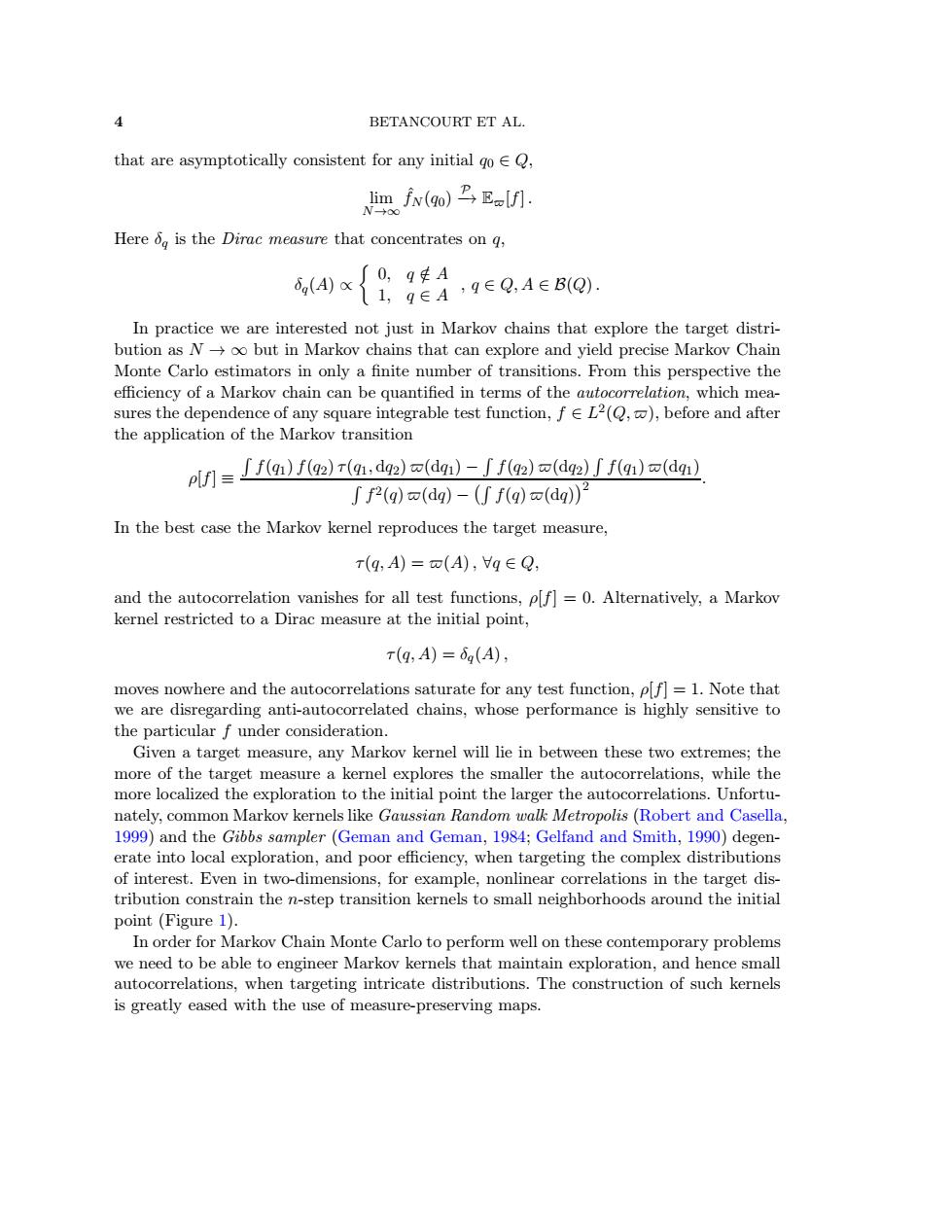正在加载图片...

BETANCOURT ET AL. that are asymptotically consistent for any initial o imx(qo)巴E-j. Here is the Dirac measure that concentrates on q, 0,9A 6(A)(Q) inte ested not just in Markov chains that Mo kov cha ins tha n only a finite n叫 ons.From this perspe tive the arkov chain can be quantified in terms of the au ntion,which mea- ny square integrable test function,feL2(,),before and after pi/1=fm)fpr,d92)oaqm)-fo2)adg2ffg)ad4l f2(q)(dq)-(ff(g)(dq)) In the best case the Markov kernel reproduces the target measure, T(q,A)=(A),g∈Q, measure at the initial point, T(q,A)=6g(A), moves nowhere and the autocorrelations saturate for any test function,pf]=1.Note that we are disregarding anti-autocorrelated chains,whose performance is highly sensitive to the particular f under consideration. Given a target measure,any Markov kernel will lie in between these two extremes;the more of the target measure a kernel explores the smaller the autocorrelations,while the more localized the exploration to the initial point the larger the autocorrelations.Unfortu- nately,common Markov kernels like Gaussian Random walk Metropolis(Robert and Casella. 1999)and the Gibbs sampler (Geman and Geman,1984;Gelfand and Smith,1990)degen- erate into local exploration,and poor efficiency,when targeting the complex distributions of interest.Even in two-dimensions,for example,nonlinear correlations in the target dis- tribution constrain the n-step transition kernels to small neighborhoods around the initial point (Figure 1). In order for Markov Chain Monte Carlo to perform well on these contemporary ce small is greatly eased with the use of measure-preserving maps.4 BETANCOURT ET AL. that are asymptotically consistent for any initial q0 ∈ Q, lim N→∞ ˆfN (q0) P −→ E̟[f] . Here δq is the Dirac measure that concentrates on q, δq(A) ∝ 0, q /∈ A 1, q ∈ A , q ∈ Q, A ∈ B(Q). In practice we are interested not just in Markov chains that explore the target distribution as N → ∞ but in Markov chains that can explore and yield precise Markov Chain Monte Carlo estimators in only a finite number of transitions. From this perspective the efficiency of a Markov chain can be quantified in terms of the autocorrelation, which measures the dependence of any square integrable test function, f ∈ L 2 (Q, ̟), before and after the application of the Markov transition ρ[f] ≡ R f(q1) f(q2) τ (q1, dq2) ̟(dq1) − R f(q2) ̟(dq2) R f(q1) ̟(dq1) R f 2(q) ̟(dq) − R f(q) ̟(dq) 2 . In the best case the Markov kernel reproduces the target measure, τ (q, A) = ̟(A), ∀q ∈ Q, and the autocorrelation vanishes for all test functions, ρ[f] = 0. Alternatively, a Markov kernel restricted to a Dirac measure at the initial point, τ (q, A) = δq(A), moves nowhere and the autocorrelations saturate for any test function, ρ[f] = 1. Note that we are disregarding anti-autocorrelated chains, whose performance is highly sensitive to the particular f under consideration. Given a target measure, any Markov kernel will lie in between these two extremes; the more of the target measure a kernel explores the smaller the autocorrelations, while the more localized the exploration to the initial point the larger the autocorrelations. Unfortunately, common Markov kernels like Gaussian Random walk Metropolis (Robert and Casella, 1999) and the Gibbs sampler (Geman and Geman, 1984; Gelfand and Smith, 1990) degenerate into local exploration, and poor efficiency, when targeting the complex distributions of interest. Even in two-dimensions, for example, nonlinear correlations in the target distribution constrain the n-step transition kernels to small neighborhoods around the initial point (Figure 1). In order for Markov Chain Monte Carlo to perform well on these contemporary problems we need to be able to engineer Markov kernels that maintain exploration, and hence small autocorrelations, when targeting intricate distributions. The construction of such kernels is greatly eased with the use of measure-preserving maps